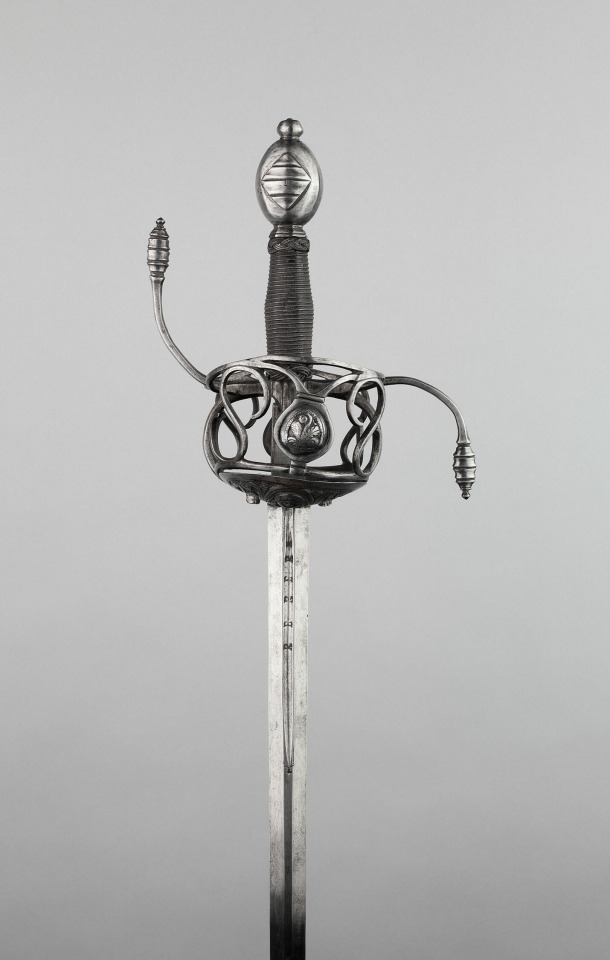Don't wanna be here? Send us removal request.
Text
17K notes
·
View notes
Photo

🦣 Report upon the extinct Vertebrata obtained in New Mexico by parties of the expedition of 1874. Washington, D.C., 1877 Original source Image description: Illustration of fossilized Mastodon productus bones from an 1877 report on extinct vertebrata found in New Mexico. The plate depicts detailed, shaded drawings of multiple large limb bones and smaller fragments, showing cracks, texture, and wear typical of aged fossils. The bones are arranged centrally with labeling numbers for scientific reference. The image emphasizes the robust, irregular shapes and surfaces of the mastodon’s skeletal remains. The top right corner notes “Plate LXXII,” confirming it as part of a larger scientific publication.
26 notes
·
View notes
Text

Axe, Turkish, 14th - 15th century
from The Metropolitan Museum of Art
2K notes
·
View notes
Text

Rapier, Western Europe, circa 1630-1640
from The Art Institute of Chicago
290 notes
·
View notes
Text
“Love is the plummet as well as the astrolabe of God’s mysteries, and the pure in heart can see far down into the depths of the divine justice, to catch a glimpse, not indeed of the details of the cosmic process, but at least of its principle and nature. These insights permit them to say […] that all shall be well, that, in spite of time, all is well, and that the problem of evil has its solution in the eternity, which men can, if they so desire, experience, but can never describe.”
— Aldous Huxley, The Perennial Philosophy
55 notes
·
View notes
Photo

🦋 Life-histories of Indian insects Calcutta: Published for the Imperial Dept. of Agriculture in India by Thacker, Spink, [1920]. Original source Image description: Historical illustration from 1920 depicting the life stages of two Indian moth species, Eucosma melanaula and Eucosma conciliata. The image shows detailed black-and-white drawings of each species’ larva, pupa, and adult moth forms. For Eucosma melanaula, the larva (a) and pupa (b) are shown on the left, with the male moth © and female moth (d) to the right, both in natural and magnified sizes. The second species, Eucosma conciliata, is displayed below with a large, segmented larva (a) above, the pupa (b) to the left, and a detailed moth © with spread wings to the right. Smaller natural size moths are also included.
17 notes
·
View notes
Text
4 notes
·
View notes
Text
““…primal people see the objects of this world not (or not only) as solid but as open windows to their divine source.”
— Huston Smith
23 notes
·
View notes
Photo

🌹 La galerie des oiseaux Paris, Constant-Chantpie, 1825-1826. Original source Image description: Rose illustration from historical archives
38 notes
·
View notes
Text
“Art is this intense form of individualism that makes the public try to exercise over it an authority that is as immoral as it is ridiculous, and as corrupting as it is contemptible. It is not quite their fault. The public have always, and in every age, been badly brought up.”
— Oscar Wilde, The Soul of Man Under Socialism
912 notes
·
View notes
Text
“Three passions have governed my life: the longing for love, the search for knowledge, and unbearable pity for the suffering of mankind.”
— Bertrand Russell, The Autobiography of Bertrand Russell
3K notes
·
View notes
Text
“It is not how things are in the world that is mystical, but that it exists.”
— Ludwig Wittgenstein, Tractatus Logico-Philosophicus
501 notes
·
View notes
Photo

🕷 Die Spinnen Amerikas Nürnberg: Verlag von Bauer & Raspe (E. Küster), 1880-1893. Original source Image description: Illustration titled “Die Spinnen Amerikas” showing three detailed spider species with eight legs, distinct body markings, and segmented abdomens. Surrounding these main spider figures are various close-up anatomical sketches, including eyes, mouthparts, leg joints, and other body segments. The drawing uses fine lines and subtle shading, capturing the intricate morphology of the spiders for scientific study. The page is pale yellow with black ink, labeled with identification numbers for each part and spider, reflecting 19th-century natural history illustration style from 1880-1893.
20 notes
·
View notes
Text
“In the “ultimate questions of life” we are not a bit nearer the truth than our ancestors were. Everybody knows it, and yet so many go on talking about infinity, without any hope of ever saying anything.”
— Lev Shestov, All Things Are Possible
107 notes
·
View notes



